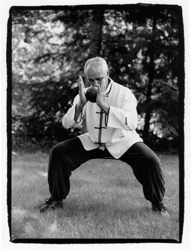Rooting means connecting to the earth, not only physically but also energetically, mentally, even spiritually. In the West we have the concept of being "grounded", but Tai Chi goes further. To be rooted means that, while we do not have actual physical roots like trees or other members of the plant kingdom, some essential aspect of ourselves is intertwined with the geography we inhabit, with nature, with the magnetic core of the earth. There are specific practices which enhance and develop these qualities, and they are found in Tai Chi more than in any other art. Indeed, it is often said that "Without rooting, there is no Tai Chi". Someone who is rooted is not only physically but psychologically stable, less prone to being imbalanced by the winds of circumstance, emotion, stress, the constant changes of external events. Rooting gives Tai Chi its unique combination of calmness and power, strength and relaxation.
In a recent episode of Qigong Radio, Don explains the meaning of Tai Chi Rooting:
[powerpress]
Turning the Hourglass Upside Down
 The great Willem de Thouars, master of internal and external martial arts, demonstrates rooting of body, mind, and spirit.
The great Willem de Thouars, master of internal and external martial arts, demonstrates rooting of body, mind, and spirit.
Another way to look at rooting is neurological: in modern society, for most people, the vast majority of actions and interactions are conducted using (primarily) the neuromuscular circuitry connecting the hands and arms, the eyes, the mouth and tongue, and the brain. We drive, we type, we text, we talk into smart phones, we cook meals--almost all the activities of daily life involve utilizing the circuitry to the upper quarter of the body. But we use other areas of our neural circuitry—those involving our legs, feet, torso, hips, and backs--far less than our ancestors did just a few generations ago; and remarkably less than the real "human animal" body (which evolved to its present form about 100,000 years ago) was designed for.
In the neurological sense, we have "turned the hourglass upside down."
Rooting rectifies this imbalance, by getting us back into our feet, our legs, back, and hips, and minimizing, at least for awhile, our reliance on the eye-hand-head circuitry.
In terms of simple biological functions, it is the reactivation of the natural support, propulsion, and adaptation circuitry of the whole body. We get to turn the neurological hourglass back, the way it was designed,and the result is both greater physical stability, and greater psychological balance.
In tomorrow's lesson, you will learn the exercise called "Ape Contemplates the Void" and experience Root with your own two legs!
Did you enjoy today's lesson?

Click here to share this course with your Friends on Facebook and help us spread the word about the potent benefits of Tai Chi Balance Training.
Did you stumble on to this page while browsing DanKleiman.com? It's part of a free, week-long Tai Chi Balance course. Learn all about it here.

Share this post
Twitter
Google+
Facebook
Reddit
LinkedIn
StumbleUpon
Pinterest
Email